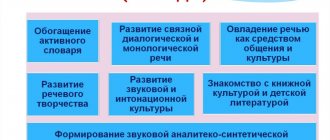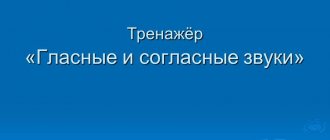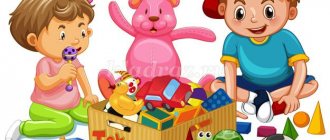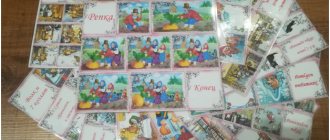At what age are children given fruit?
Accustoming your baby to fruits right from the cradle is not the best idea. They can irritate the intestines that are not yet strong and cause an allergic rash. Introduce fruits into your child’s diet gradually, from about 8-9 months. You should start with 1/2 tsp. juice If no negative reaction is observed, you can continue.
You can introduce pureed fruits that suit your baby. Later, when the first teeth begin to appear, you can gradually give fruit in pieces. This will help strengthen your teeth and gums. Fruits and berries, which are strong allergens, are best left for the 2nd year of the baby’s life.
Games
It is useful to organize various educational games for children with images of fruits. Here are some examples:
- Guess what?
Identify the hidden fruit from the description by selecting its image from several laid out on the table.
- Let's fill the basket
Find among the drawn fruits one about which you can say:
– round, rosy, sweet; – bright, aromatic, sour; – leathery, heavy, smooth, etc.
The card with the guessed fruit is put into a box on which a basket of fruit is drawn among the trees.
- Fourth wheel
Select four pictures so that three have something in common, and the fourth is superfluous.
For example: dried apricots, apple, prunes, raisins (three are dried fruits, but the apple is not).
For this game you can use additional cards: berries and fruits, for example.
- Ripe alphabet
Choose any letter, and then, as quickly as possible, remember a fruit or several whose names begin with it. It’s good if the complete “fruit alphabet” in pictures is used for other games and the child is already familiar with it.
- Whose piece?
Based on the image of the cut, you need to guess the whole fruit as quickly as possible.
- Harvesting
Using fruits on a transparent background, create a beautiful still life on a special screen. The full fruit basket is then closed and the child is asked to name everything that is inside it.
Should I give my child exotic fruits?
Scientists and doctors have long proven that a child’s body responds better to the products of the area and region in which he grew up. That is, it is better to start complementary feeding with domestic apples and pears. Even bananas and oranges are best not given until 2 years of age.
You should not give exotic fruits - mango, papaya or lychee - from an early age. It’s better to let your baby’s body get stronger, let his digestive system work fully and correctly. There is no need to give her surprises in the form of unusual fruits, at least until she is 4-5 years old.
Fruits contribute to the harmonious and healthy development of the child’s body because they contain a large amount of vitamins and minerals. But do not forget that excessive consumption of any fruit can cause allergies and other unpleasant consequences. In everything you need to observe moderation.
Tasks
Examples of tasks that can be used during lessons on the topic “Fruits”:
- Describe the appearance of several fruits using object pictures with their images.
- Compare two similar fruits (apple-peach, pear-quince, tangerine-orange), listing in detail all the common features and differences.
- Name as many characteristics of the fruit shown on the card as possible. One child, children in pairs, or the whole group can list adjectives in a circle.
- Make up a story based on the plot picture, and also come up with several questions for each picture. You can use the following options: “Fruit basket”, “How dried fruits are made”, “From seed to apple”.
- Choose an image of one fruit and come up with as many dishes from it as possible, using the correct name for each (plum marmalade - plum caramel - plum jam).
- Write riddles or short funny poems about fruits on cards.
- Carefully examine one of the pictures, and then, from memory, describe in great detail the fruit that is depicted in it.
- Make up stories in pictures based on several drawings on a topic that are related to each other.
- Using various dried and fresh fruits drawn, come up with a fairy tale about them, compose a short dialogue, and act out (using cards) a short scene.
Fruit basket
Peach
Mandarin
Lemon
Kiwi
Pear
Pomegranate
Banana
Quince
Plum
Cherry
Persimmon
Music on the theme "Fruit"
Karen Khachaturyan "Cipollino - Prince Lemon"
The middle of the 20th century can be called, without exaggeration, the “golden age” of Russian animation. The artists carefully worked out every stroke, the cartoons were voiced by first-class actors, and great attention was paid to music. The music was bright, memorable, imaginative, capable of capturing a child’s imagination.
For example, remember the wonderful cartoon “Chippolino”, created at the Soyuzmultfilm studio by director B.P. Dezhkin in 1961. I still remember the bright musical compositions that sounded in the cartoon. The music for this cartoon was written by the great Soviet composer Karen Khachaturyan. 13 years later, based on this music, Karen Khachaturian created a children's ballet of the same name.
According to the composer, Gianni Rodari’s fairy tale captivated him so much that its characters lived in his imagination for a long time. “I couldn’t forget the cheerful Cipollino, the gentle Radish, the noble Cherry, the evil, loud Lemon... And for some reason, each hero now appeared to me in a dance,” admitted Karen Surenovich. Thus was born the idea of a ballet, which was embodied in a complete work in 1974. The choreography for the ballet was composed by choreographer Genrikh Mayorov.
The fate of the ballet was brilliant from the very beginning. The composer became famous throughout the world, and the ballet itself became one of the best in contemporary art aimed at children. The main roles in the ballet were performed by such famous dancers as Maris Liepa, Nikolai Tsiskaridze, Nina Sorokina, Marina Kondratieva and many others.
Some information about Karen Khachaturyan. He was born in Moscow into the family of a theater director. In 1949, Karen graduated from the Moscow Conservatory. His teachers and mentors included Dmitri Shostakovich, Sergei Prokofiev and Igor Stravinsky. Shostakovich emphasized Karen Khachaturian’s “depth of thought, masterly development of material, perfection of its implementation, beautifully flowing melodies, amazing sounds.” Karen Khachaturian composed music for symphony and small orchestras, for violin, cello and piano. Wrote five symphonies. Since 1950, Karen Khachaturian has written music for films and cartoons. The most famous of them were: music for “Cipollino” and for the film “Viy” with Natalya Varleya. In 1981 he was awarded the title of People's Artist of the RSFSR.
We invite you to watch the wonderful cartoon “Chippolino” with your children. And discuss many of the topics raised in the cartoon: mutual assistance, courage, inequality. Well, and, of course, find heroes who belong to vegetables. And the music, of course, listen more carefully to the music written by Karen Khachaturyan.
TOP 15 best fruits for baby food
Fruits can be used as a snack or replaced with candies and sweets. They are rich in vitamins of various groups: A, B, C. They contain iodine, zinc, iron, selenium, as well as macroelements such as phosphorus, sodium, calcium, magnesium.
It is better to choose fruits according to the season, since the quality of imported products can be doubtful. Give your child a variety of fruits; don’t just focus on apples or bananas.
Hard fruits are useful and pleasant to chew on; it develops teeth and gums. It is advisable to eat fruits fresh, but for variety you can bake them.
Grapefruit
Grapefruit is considered very useful due to its high dose of vitamin C, minerals, essential oils, fiber and phytoncides. Phytoncides help suppress the growth and development of bacteria in the child’s body, and fiber contributes to the normal functioning of the gastrointestinal system.
Thanks to a large amount of vitamin C, grapefruit fights diseases and infections, helps with colds and viral diseases. Its regular use will support the child’s body during the period of spring and autumn vitamin deficiency.
Grapefruit is recommended to be included in the diet of children with diseases of the cardiovascular system. Vitamin B helps regulate the functioning of the child’s nervous system. This fruit increases stamina and helps fight drowsiness and lethargy.
The only drawback of grapefruit for children is its bitter taste. But it is not contained in the whole fruit, but only in the partitions and films. The pulp itself is sweet and juicy, pleasant to the taste.
It is better to eat grapefruit fresh; you can add it to fruit salads or make juice. But be careful with the juice - a high concentration of vitamin C can cause allergic rashes and irritation of the gastric mucosa. Mix concentrated juice with water.
Apples
Only the lazy have not heard about the benefits of apples: “Whoever eats an apple a day never sees a doctor,” says the famous saying. Apples are rich in vitamins C and B, iron, potassium, antioxidants, pectin and fiber.
Pectin helps remove toxic substances from the child’s body and cleanse it. It also helps normalize the functioning of the gastrointestinal tract and improves appetite.
Thanks to iron, apples improve the composition of a child’s blood and are prescribed for childhood anemia. Apples contain a lot of vitamin C, so they help fight viral and colds. Thanks to the content of vitamin B6, they promote sound sleep for the child.
Most of the nutrients are found in the peel and seeds of the apple. It is better to give it to the child whole, or cut into slices.
Lemon
Lemons have a sharp, sour taste, so including them in children's diets is not easy. But it’s worth it: lemon ranks first among fruits in terms of vitamin C content. It will kill any cold at the initial stage, and you will be able to avoid the use of antibiotics and other medications.
Lemon has antibacterial and antiviral effects thanks to vitamin C and phytoncides, which remove toxic substances from the body and fight infections. Due to the high concentration of vitamins in lemon, it supports the child’s immunity and helps avoid illnesses during vitamin deficiency.
Doctors recommend including lemon in a child’s diet no earlier than 1 year. You can sprinkle sugar on lemon and add it to tea or drink it as juice diluted with water. But be careful: when including lemon in the diet, monitor all changes in the child’s body. Like any citrus fruit, it is a strong allergen and can cause stomach irritation.
Banana
Bananas have become a part of our daily diet. This fruit is rich in fiber, vitamins C and B, the amino acid tryptophan, as well as calcium, iron, and potassium.
Due to the content of B vitamins, bananas are beneficial for the nervous system. They promote the production of the happiness hormone endorphin - due to the amino acid tryptophan. Bananas help improve the functioning of the gastrointestinal tract and help with diseases of the cardiovascular system.
Banana is a high-calorie fruit; you should limit its consumption to 1 piece per day if your child is overweight. You will have to exclude it from the diet if you are allergic to it.
Orange
Orange is a fruit rich in vitamins, minerals, and antioxidants. 100 g of orange contains the daily requirement of vitamin C for an adult.
Orange is considered the leader in effectiveness in the fight against colds and flu. It will become a reliable helper for a child during epidemics and vitamin deficiency. Salicylic acid will help relieve fever if you do get sick, and improves immunity.
It is better to eat oranges fresh; you can drink freshly squeezed juice if you are not allergic. But the juice contains less fiber than the whole fruit and only retains its beneficial effects for 30 minutes.
Pear
Pear is a tasty and healthy fruit with a high content of B vitamins. It contains ascorbic acid, calcium, sodium, iron, phosphorus and magnesium. It is a source of fiber, which helps the functioning of the gastrointestinal tract.
Ascorbic acid in pears will help cope with various colds: reduce fever, relieve symptoms. The body will be able to fight the virus on its own.
Pears can be consumed whole, cut into slices, or added to compote.
A pineapple
Pineapple is not the most familiar fruit for Russian residents; we often see foreign products in stores. It is rich in vitamins B and C, special alkaloid substances, beneficial acids and minerals.
Thanks to its mineral and vitamin complex, as well as ascorbic acid in its composition, pineapples help fight viral and colds. Pineapple contains the substance bromelain - it helps fight excess weight by improving metabolism and accelerating the process of fat breakdown.
If your child is overweight, pineapple will help get rid of it.
The fruit stimulates digestion and helps remove harmful substances from the body. It is better to buy fresh, juicy fruits rather than canned ones - they contain too much sugar.
Mandarin
It is simply a storehouse of nutrients, minerals and amino acids. It is rich in vitamins A, B, C and D, magnesium, iron, calcium and sodium.
Tangerines improve the functioning of the cardiovascular, nervous and digestive systems, promote concentration and energize. The fruit helps get rid of insomnia, diarrhea, and depression.
Tangerines are excellent at fighting colds and infections, easing the course of the disease, and increasing immunity. They strengthen the child’s teeth and bones, improve mood, quench thirst, and reduce temperature.
When including tangerines in a child’s diet, you need to carefully monitor his body’s reaction; tangerines are a strong allergen. It is better not to give your child fruit before 1 year of age.
Apricot
Apricot is a source of vitamins A, B and C, minerals, phosphorus and pectin. This fruit helps cope with infectious and viral diseases, normalizes intestinal function, helps the pancreas and kidneys, and improves immunity.
Apricots accelerate metabolism and cell regeneration, and help heal wounds on the body. They are rich in iron, so they are included in the diet of children with anemia or to prevent it.
You can eat apricots fresh, dried, cook compote from it and make jam or jam.
Persimmon
Persimmon is a generous source of vitamins and minerals for children's bodies. Has an astringent effect. Rich in vitamins A, C and P, carotene, iodine, iron.
Persimmon helps improve vision, is a natural energy booster, and charges your child with vigor and energy for the whole day. Helps fight viral infections, strengthens the cardiovascular system, improves the functioning of the nervous system. Due to its high iodine content, persimmon is also beneficial for the child’s endocrine system.
Persimmon should not be given to a child under 3 years of age; its astringent properties can cause intestinal obstruction. After introducing persimmons into the diet, carefully monitor the child’s condition and note any changes in his body.
Plum
Plums are rich in vitamins B, E and P, iron, phosphorus, calcium, pectin and iodine. Their composition helps the functioning of your child's gastrointestinal, endocrine and nervous systems. It also strengthens bones and teeth.
The fruit improves digestion and appetite, promotes the formation of red blood cells in the blood, strengthens the liver and kidneys, and the walls of blood vessels. Plums can be used to lower body temperature during colds or flu.
In large quantities, plums can cause diarrhea. Make sure your child doesn't eat too much.
The optimal age for a child to introduce plums into his diet is 8-9 months, not earlier. You can make puree, juice from them, and also add them to desserts.
Cherry
Cherry is considered the queen of fruits and is rich in vitamins A, C and E, iron, phosphorus, magnesium, calcium, pectin, and ascorbic acid.
Cherries contain coumarin, which helps improve blood quality. It reduces its viscosity and is used to prevent the formation of blood clots. Pectins improve the functioning of the gastrointestinal tract, vitamins C fight colds and viral diseases.
Ascorbic acid boosts immunity and relieves cold and flu symptoms. Cherries may improve the effectiveness of medications in the treatment of epilepsy in children.
Children may find cherries too sour; you can make jam and jam with added sugar, compotes and fruit drinks from them.
Cherries
Cherries contain vitamins E, C, H, P and group B, micro and macroelements - potassium, calcium, phosphorus, copper, iodine, zinc and others. Cherries boost immunity and give your children a boost of vigor and energy.
It helps the heart function, maintains proper heart rhythm, and strengthens the walls of blood vessels. Being a natural antioxidant, cherries remove harmful and toxic substances from the body. The high content of vitamin C and ascorbic acid speeds up the recovery process from a cold or flu.
Cherries are a strong allergen, so after introducing them into your child’s diet, carefully monitor his reaction. You can start trying to give cherries to your child from 8-9 months in the form of juice, compotes or fruit drinks.
Grape
Scientists still cannot decide: are grapes a berry or a fruit? It is called a wineberry, but we are accustomed to perceive it as a fruit. Grapes are rich in vitamins A, B, C and D, calcium, phosphorus, ascorbic acid, potassium and magnesium.
Grapes have a general healing effect, keep the immune system in good shape, and are useful for the respiratory system of the body. The berry (or fruit) has a beneficial effect on the digestion process, however, it is important not to overuse it - in large quantities, grapes can cause intestinal upset and diarrhea.
Strengthens the nervous system, helps to overcome stressful situations more easily. It has a positive effect on mental activity; its effect can be compared to chocolate.
Grapes are a high-calorie product; you should not abuse them, especially for overweight children.
It is recommended to introduce it into the baby’s diet no earlier than 2 years. This is mainly due to the load on the organs of the digestive tract. Give the grapes a little at a time, carefully monitoring the body's reaction.
Peach
Rich in malic and citric acids, vitamins C, B and E, carotene, pectin and other beneficial substances. Promotes good functioning of the digestive tract, cardiovascular system, as well as the nervous and protective systems.
The substances contained in peach help strengthen the child’s muscle corset and his skeleton. Thanks to zinc and phosphorus, internal organs will develop correctly. Peach is great for fighting colds and viral infections.
Paintings on the theme “Fruit”
Ilya Efimovich Repin “Apples and Leaves”
We all know Ilya Efimovich Repin as a master of portraiture and a master of large canvases on mythological and historical themes (for example, the painting “Barge Haulers on the Volga,” which we discussed in the topic “Professions”). Still life was not the artist’s main genre, and we can say that the painting “Apples and Leaves” was created by accident. The still life, combining fruits and leaves, was created and staged by Repin for his student, young V.A. Serova. But the teacher liked the composition so much that he decided to paint such a still life himself.
A completely simple plot: six apples from the garden and a heap of leaves, but it’s all so native, Russian, realistic. The yellowish-green and red apples are not depicted as ideal “waxy” fruits, but as real, living fruits should look. It is felt that they have irregularities, dents and small spots. The simplicity of the painting makes the canvas a masterpiece worthy of the world's best halls and exhibitions.
Ilya Efimovich Repin loved nature very much. He lived 86 years and until his old age he slept in the cold, swam in the sea, never spent a day without gymnastics and ate a lot of vegetables and fruits. If Repin had a break from drawing, he found other activities for himself - riding a horse, swimming, working in the garden, planting plants or clearing snow in winter. And he did not hesitate to offer shovels to his guests, for example, Chukovsky, Mayakovsky or Chaliapin. Proper nutrition, physical activity, favorite work and the ability to live simply (without frills) are the main secrets of the longevity of the great artist. As in the painting “Apples and Leaves,” beauty is in simplicity.
Paul Cezanne "Still life with drapery, jug and fruit bowl"



